Analyzing Leadership Styles in the Case Study Report
VerifiedAdded on 2022/12/29
|12
|1179
|79
Report
AI Summary
This report analyzes leadership styles demonstrated in a case study involving a team of trekkers encountering a crisis. The analysis focuses on the leadership approaches of the New Zealander (autocratic), Stephen the anthropologist (laissez faire), and the Sherpa Pasang (participatory). The report defines each leadership style, providing examples from the case study to illustrate their characteristics. The New Zealander's autocratic approach is shown through his decisive actions and focus on the team's primary goal, while Stephen's laissez-faire approach is highlighted by his trust in his team's abilities. Pasang's participatory leadership is illustrated by his collaboration with Stephen. The report concludes by evaluating the effectiveness of each leadership style within the context of the case study, demonstrating how individual leaders adapted their styles to the situation and how their actions impacted the team dynamics. The report aims to assess the advantages and disadvantages of each leadership style.

Leadership
Styles
Styles
Paraphrase This Document
Need a fresh take? Get an instant paraphrase of this document with our AI Paraphraser
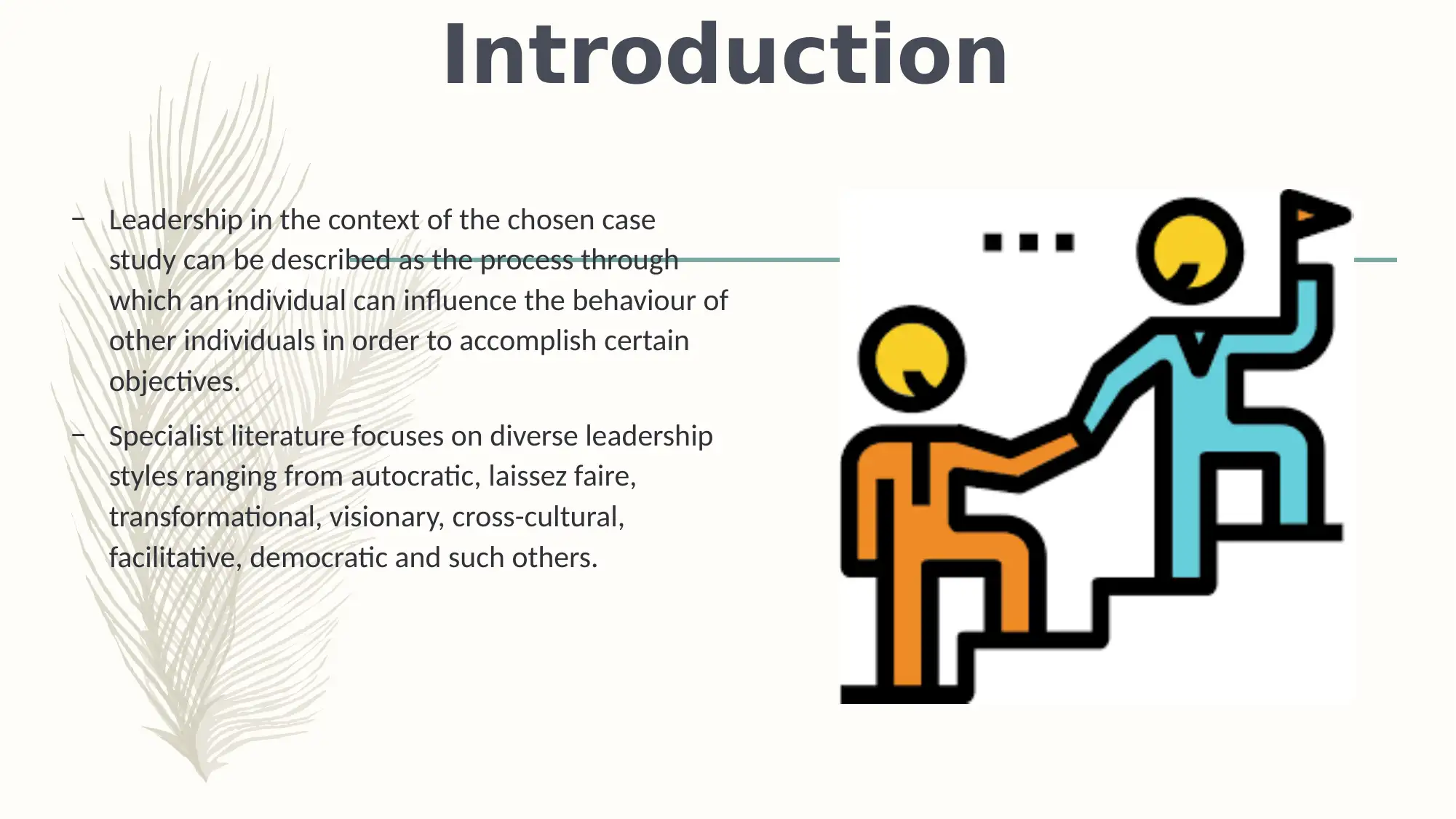
Introduction
– Leadership in the context of the chosen case
study can be described as the process through
which an individual can influence the behaviour of
other individuals in order to accomplish certain
objectives.
– Specialist literature focuses on diverse leadership
styles ranging from autocratic, laissez faire,
transformational, visionary, cross-cultural,
facilitative, democratic and such others.
– Leadership in the context of the chosen case
study can be described as the process through
which an individual can influence the behaviour of
other individuals in order to accomplish certain
objectives.
– Specialist literature focuses on diverse leadership
styles ranging from autocratic, laissez faire,
transformational, visionary, cross-cultural,
facilitative, democratic and such others.
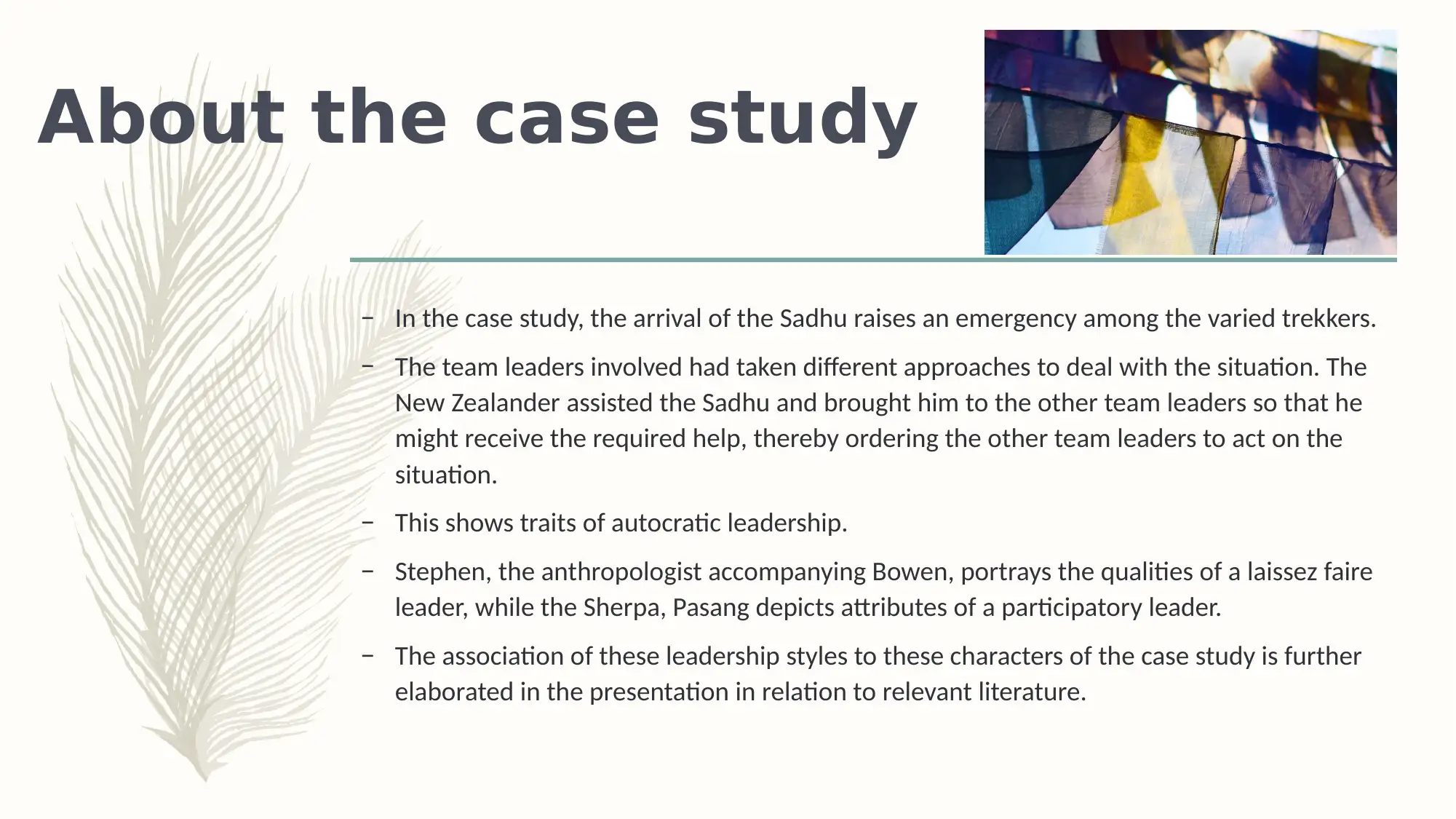
About the case study
– In the case study, the arrival of the Sadhu raises an emergency among the varied trekkers.
– The team leaders involved had taken different approaches to deal with the situation. The
New Zealander assisted the Sadhu and brought him to the other team leaders so that he
might receive the required help, thereby ordering the other team leaders to act on the
situation.
– This shows traits of autocratic leadership.
– Stephen, the anthropologist accompanying Bowen, portrays the qualities of a laissez faire
leader, while the Sherpa, Pasang depicts attributes of a participatory leader.
– The association of these leadership styles to these characters of the case study is further
elaborated in the presentation in relation to relevant literature.
– In the case study, the arrival of the Sadhu raises an emergency among the varied trekkers.
– The team leaders involved had taken different approaches to deal with the situation. The
New Zealander assisted the Sadhu and brought him to the other team leaders so that he
might receive the required help, thereby ordering the other team leaders to act on the
situation.
– This shows traits of autocratic leadership.
– Stephen, the anthropologist accompanying Bowen, portrays the qualities of a laissez faire
leader, while the Sherpa, Pasang depicts attributes of a participatory leader.
– The association of these leadership styles to these characters of the case study is further
elaborated in the presentation in relation to relevant literature.
⊘ This is a preview!⊘
Do you want full access?
Subscribe today to unlock all pages.

Trusted by 1+ million students worldwide
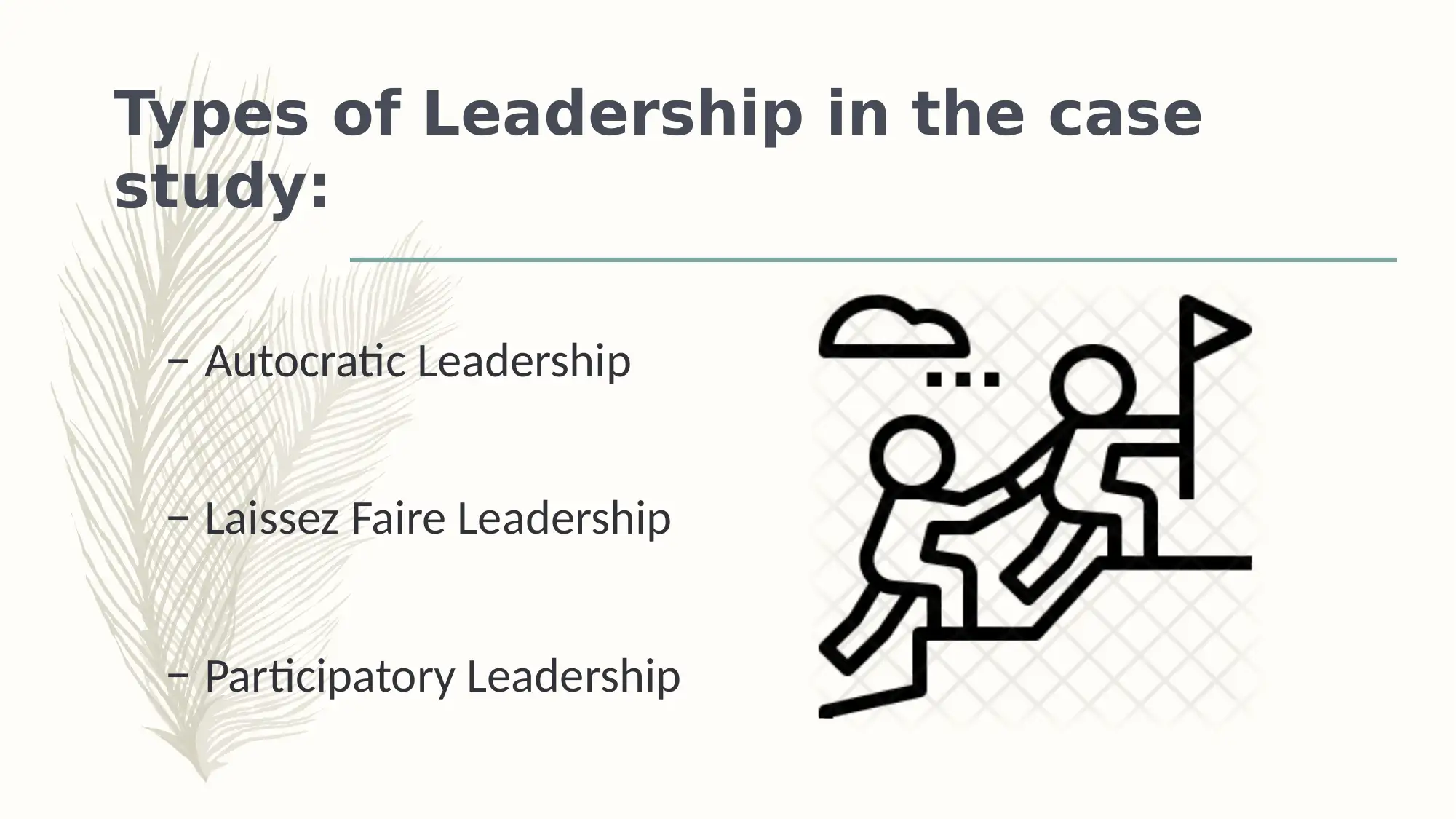
Types of Leadership in the case
study:
– Autocratic Leadership
– Laissez Faire Leadership
– Participatory Leadership
study:
– Autocratic Leadership
– Laissez Faire Leadership
– Participatory Leadership
Paraphrase This Document
Need a fresh take? Get an instant paraphrase of this document with our AI Paraphraser
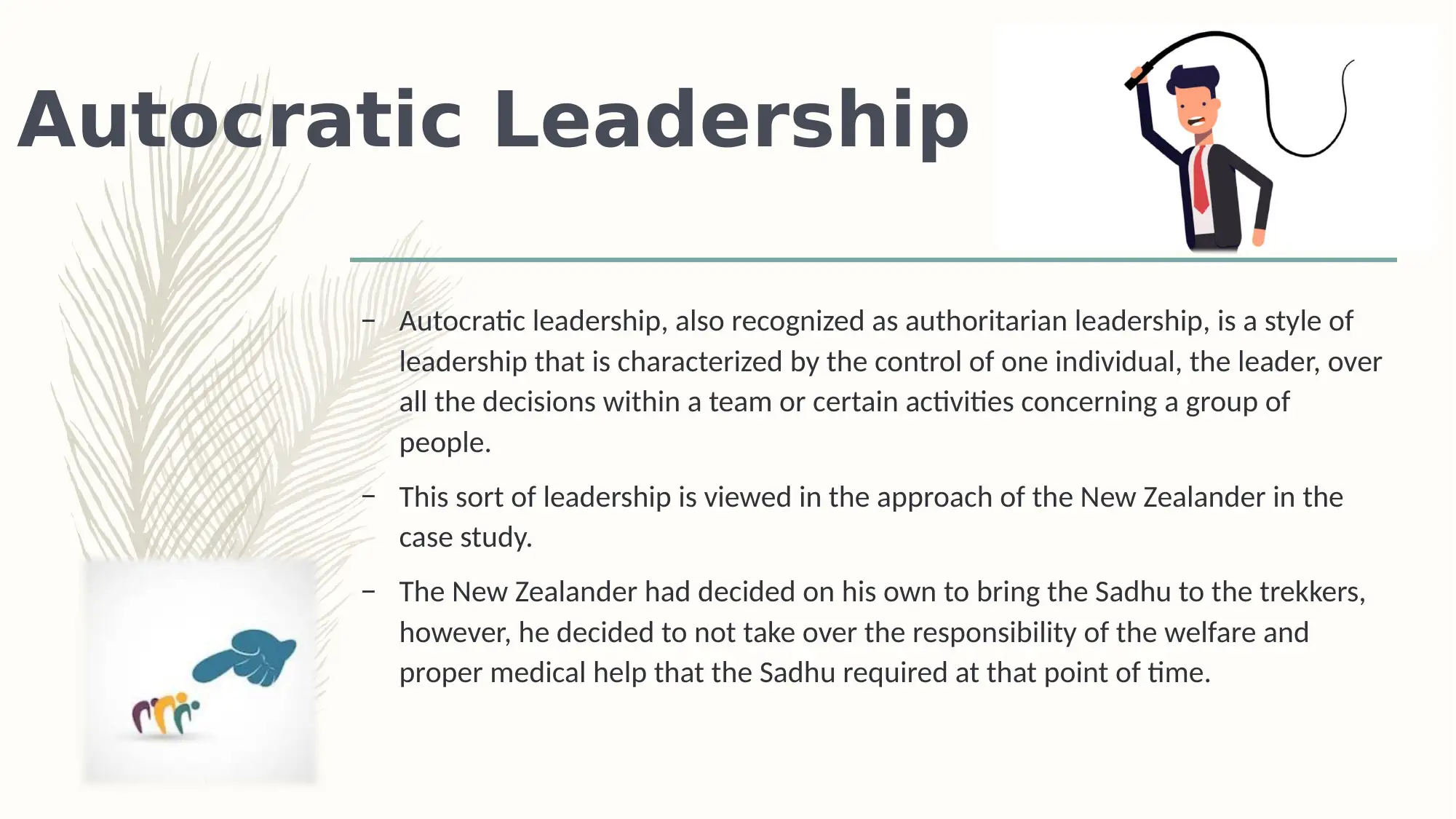
Autocratic Leadership
– Autocratic leadership, also recognized as authoritarian leadership, is a style of
leadership that is characterized by the control of one individual, the leader, over
all the decisions within a team or certain activities concerning a group of
people.
– This sort of leadership is viewed in the approach of the New Zealander in the
case study.
– The New Zealander had decided on his own to bring the Sadhu to the trekkers,
however, he decided to not take over the responsibility of the welfare and
proper medical help that the Sadhu required at that point of time.
– Autocratic leadership, also recognized as authoritarian leadership, is a style of
leadership that is characterized by the control of one individual, the leader, over
all the decisions within a team or certain activities concerning a group of
people.
– This sort of leadership is viewed in the approach of the New Zealander in the
case study.
– The New Zealander had decided on his own to bring the Sadhu to the trekkers,
however, he decided to not take over the responsibility of the welfare and
proper medical help that the Sadhu required at that point of time.
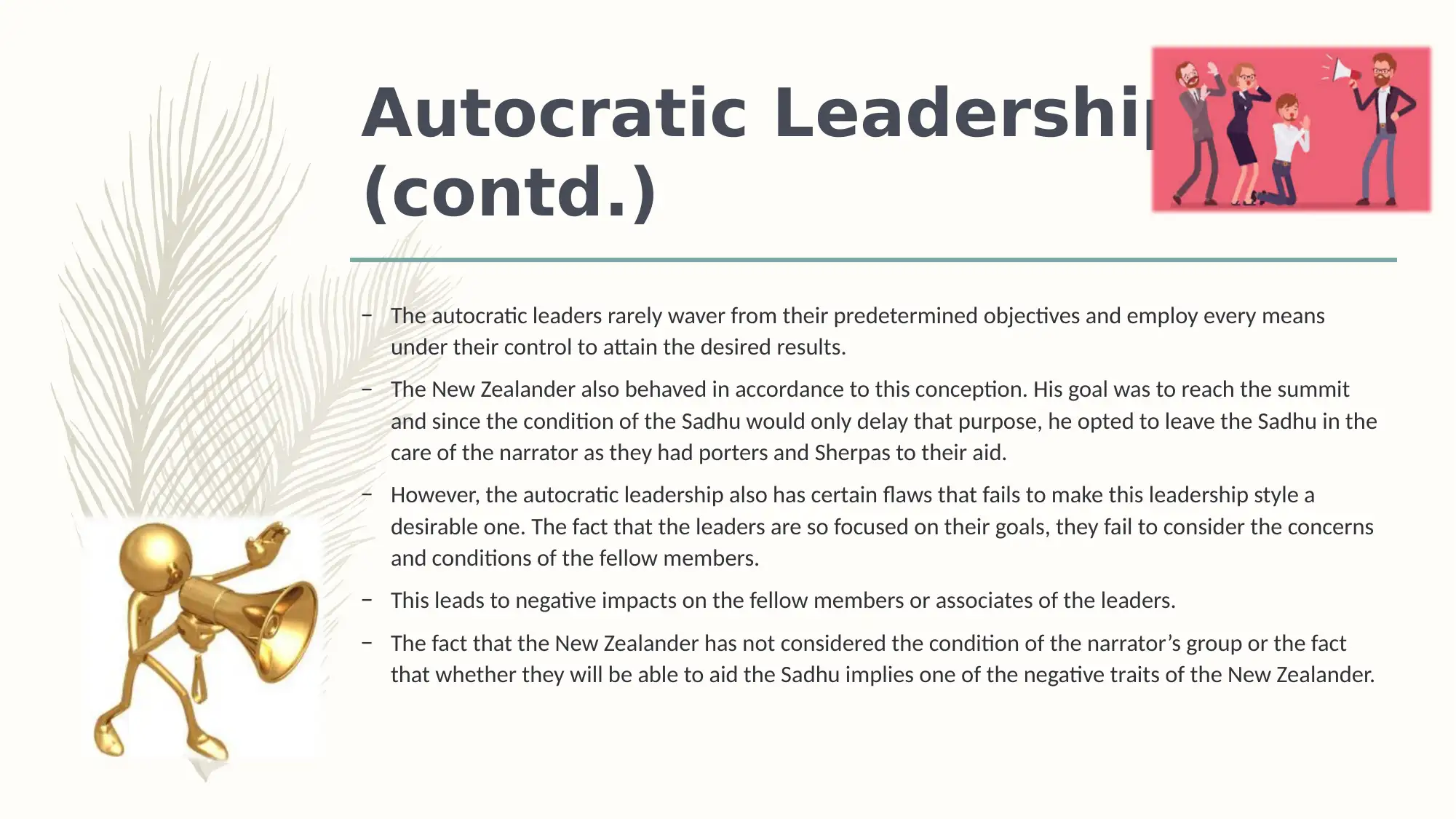
Autocratic Leadership
(contd.)
– The autocratic leaders rarely waver from their predetermined objectives and employ every means
under their control to attain the desired results.
– The New Zealander also behaved in accordance to this conception. His goal was to reach the summit
and since the condition of the Sadhu would only delay that purpose, he opted to leave the Sadhu in the
care of the narrator as they had porters and Sherpas to their aid.
– However, the autocratic leadership also has certain flaws that fails to make this leadership style a
desirable one. The fact that the leaders are so focused on their goals, they fail to consider the concerns
and conditions of the fellow members.
– This leads to negative impacts on the fellow members or associates of the leaders.
– The fact that the New Zealander has not considered the condition of the narrator’s group or the fact
that whether they will be able to aid the Sadhu implies one of the negative traits of the New Zealander.
(contd.)
– The autocratic leaders rarely waver from their predetermined objectives and employ every means
under their control to attain the desired results.
– The New Zealander also behaved in accordance to this conception. His goal was to reach the summit
and since the condition of the Sadhu would only delay that purpose, he opted to leave the Sadhu in the
care of the narrator as they had porters and Sherpas to their aid.
– However, the autocratic leadership also has certain flaws that fails to make this leadership style a
desirable one. The fact that the leaders are so focused on their goals, they fail to consider the concerns
and conditions of the fellow members.
– This leads to negative impacts on the fellow members or associates of the leaders.
– The fact that the New Zealander has not considered the condition of the narrator’s group or the fact
that whether they will be able to aid the Sadhu implies one of the negative traits of the New Zealander.
⊘ This is a preview!⊘
Do you want full access?
Subscribe today to unlock all pages.

Trusted by 1+ million students worldwide
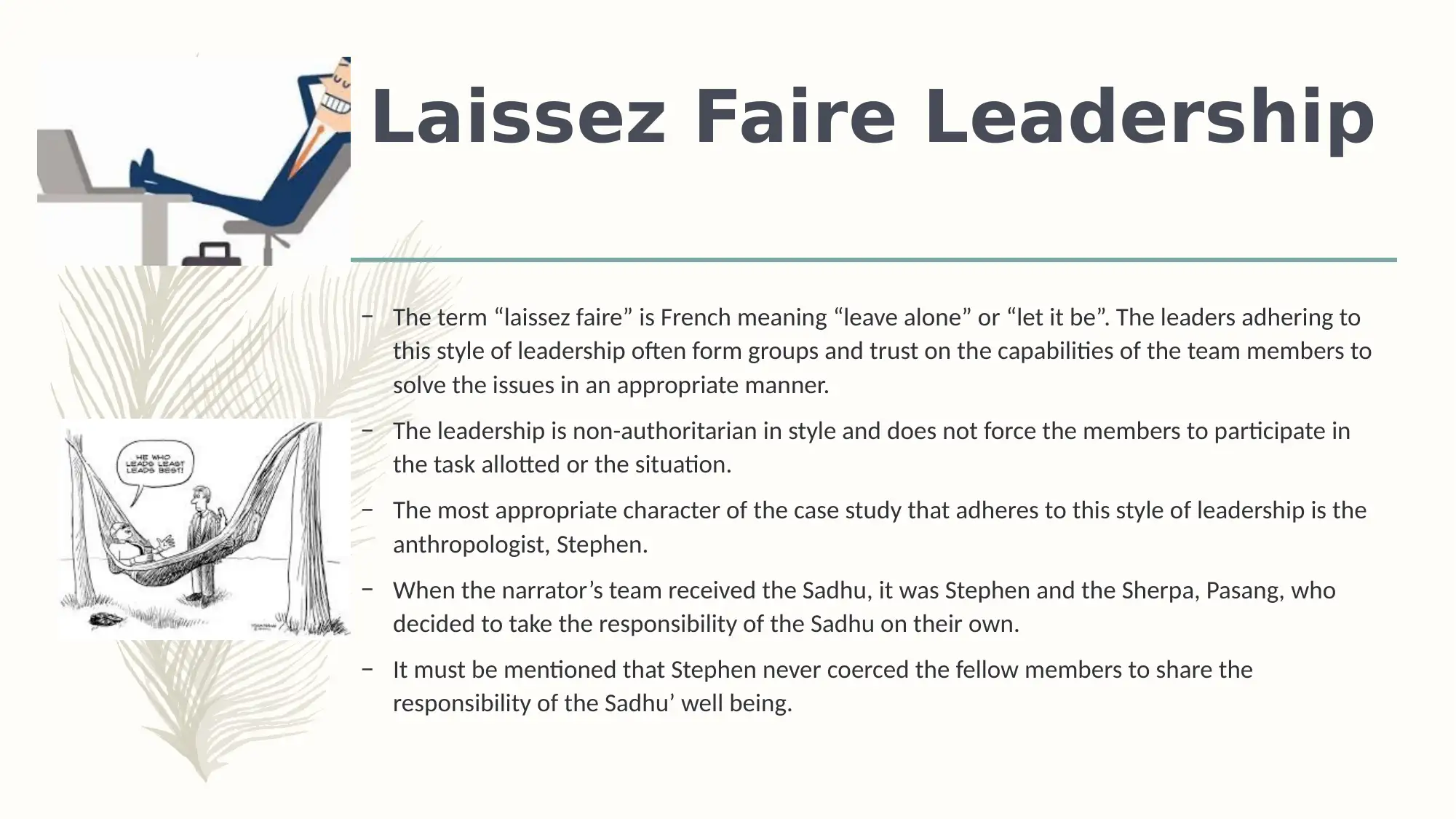
Laissez Faire Leadership
– The term “laissez faire” is French meaning “leave alone” or “let it be”. The leaders adhering to
this style of leadership often form groups and trust on the capabilities of the team members to
solve the issues in an appropriate manner.
– The leadership is non-authoritarian in style and does not force the members to participate in
the task allotted or the situation.
– The most appropriate character of the case study that adheres to this style of leadership is the
anthropologist, Stephen.
– When the narrator’s team received the Sadhu, it was Stephen and the Sherpa, Pasang, who
decided to take the responsibility of the Sadhu on their own.
– It must be mentioned that Stephen never coerced the fellow members to share the
responsibility of the Sadhu’ well being.
– The term “laissez faire” is French meaning “leave alone” or “let it be”. The leaders adhering to
this style of leadership often form groups and trust on the capabilities of the team members to
solve the issues in an appropriate manner.
– The leadership is non-authoritarian in style and does not force the members to participate in
the task allotted or the situation.
– The most appropriate character of the case study that adheres to this style of leadership is the
anthropologist, Stephen.
– When the narrator’s team received the Sadhu, it was Stephen and the Sherpa, Pasang, who
decided to take the responsibility of the Sadhu on their own.
– It must be mentioned that Stephen never coerced the fellow members to share the
responsibility of the Sadhu’ well being.
Paraphrase This Document
Need a fresh take? Get an instant paraphrase of this document with our AI Paraphraser
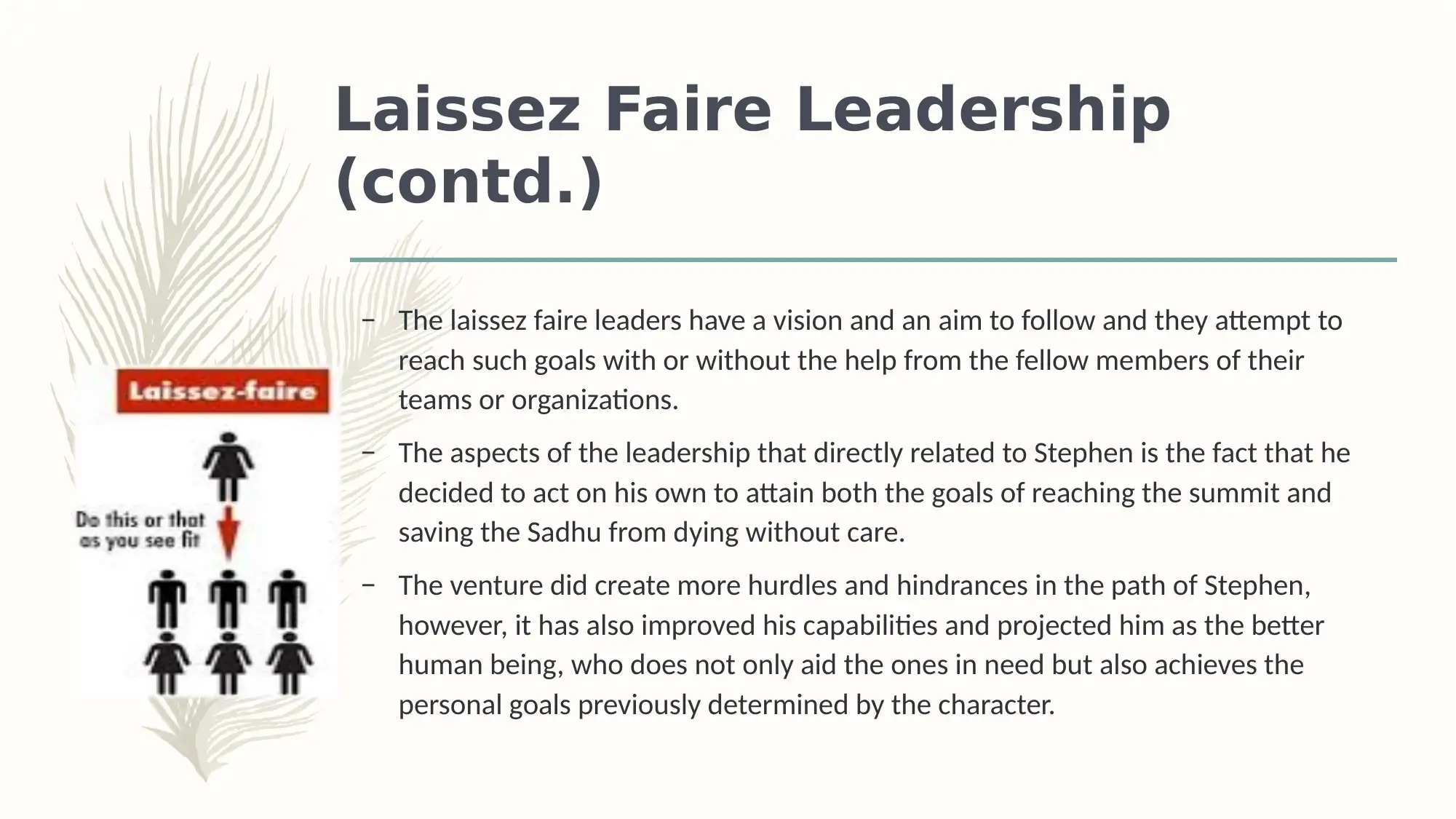
Laissez Faire Leadership
(contd.)
– The laissez faire leaders have a vision and an aim to follow and they attempt to
reach such goals with or without the help from the fellow members of their
teams or organizations.
– The aspects of the leadership that directly related to Stephen is the fact that he
decided to act on his own to attain both the goals of reaching the summit and
saving the Sadhu from dying without care.
– The venture did create more hurdles and hindrances in the path of Stephen,
however, it has also improved his capabilities and projected him as the better
human being, who does not only aid the ones in need but also achieves the
personal goals previously determined by the character.
(contd.)
– The laissez faire leaders have a vision and an aim to follow and they attempt to
reach such goals with or without the help from the fellow members of their
teams or organizations.
– The aspects of the leadership that directly related to Stephen is the fact that he
decided to act on his own to attain both the goals of reaching the summit and
saving the Sadhu from dying without care.
– The venture did create more hurdles and hindrances in the path of Stephen,
however, it has also improved his capabilities and projected him as the better
human being, who does not only aid the ones in need but also achieves the
personal goals previously determined by the character.
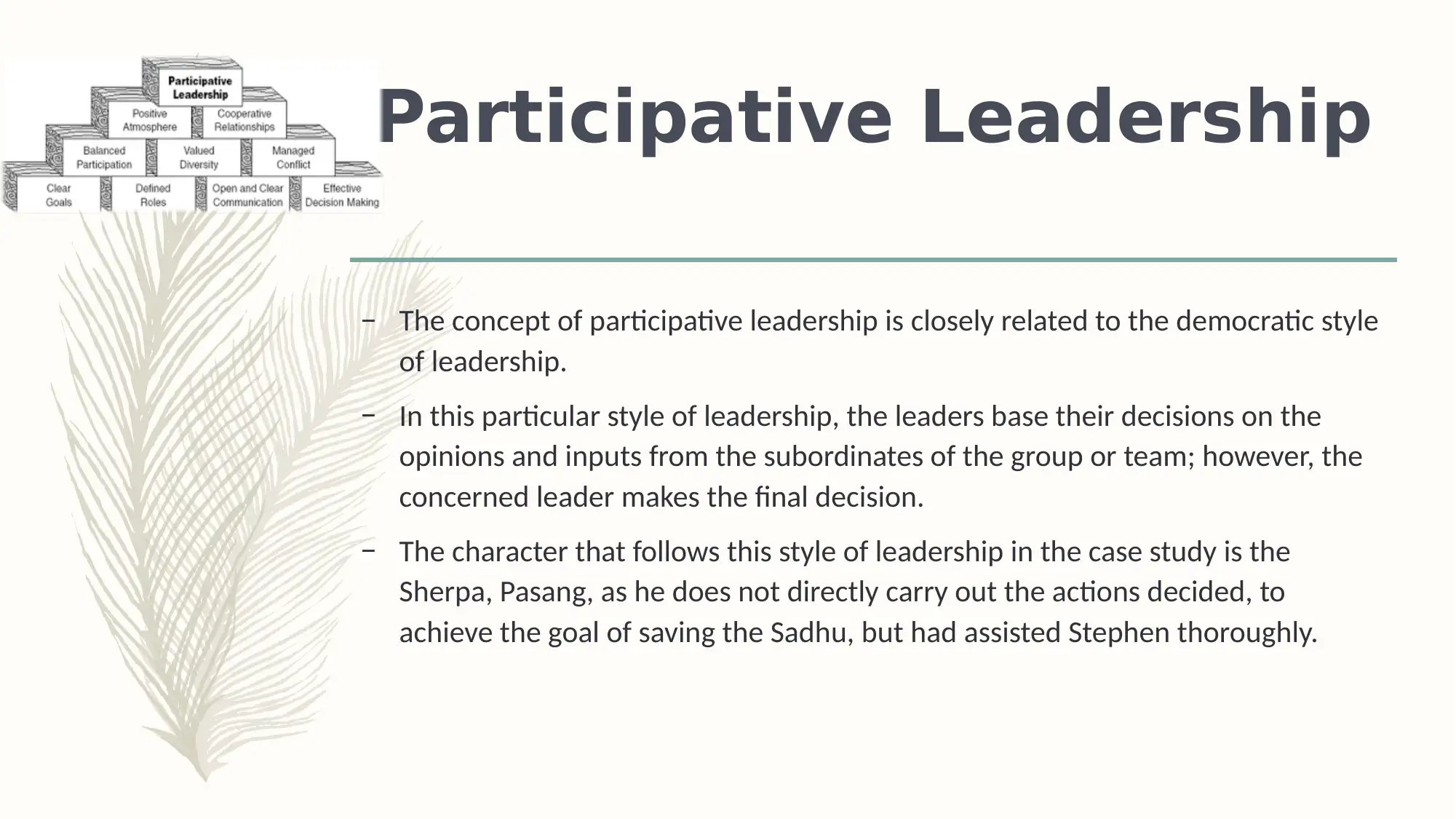
Participative Leadership
– The concept of participative leadership is closely related to the democratic style
of leadership.
– In this particular style of leadership, the leaders base their decisions on the
opinions and inputs from the subordinates of the group or team; however, the
concerned leader makes the final decision.
– The character that follows this style of leadership in the case study is the
Sherpa, Pasang, as he does not directly carry out the actions decided, to
achieve the goal of saving the Sadhu, but had assisted Stephen thoroughly.
– The concept of participative leadership is closely related to the democratic style
of leadership.
– In this particular style of leadership, the leaders base their decisions on the
opinions and inputs from the subordinates of the group or team; however, the
concerned leader makes the final decision.
– The character that follows this style of leadership in the case study is the
Sherpa, Pasang, as he does not directly carry out the actions decided, to
achieve the goal of saving the Sadhu, but had assisted Stephen thoroughly.
⊘ This is a preview!⊘
Do you want full access?
Subscribe today to unlock all pages.

Trusted by 1+ million students worldwide
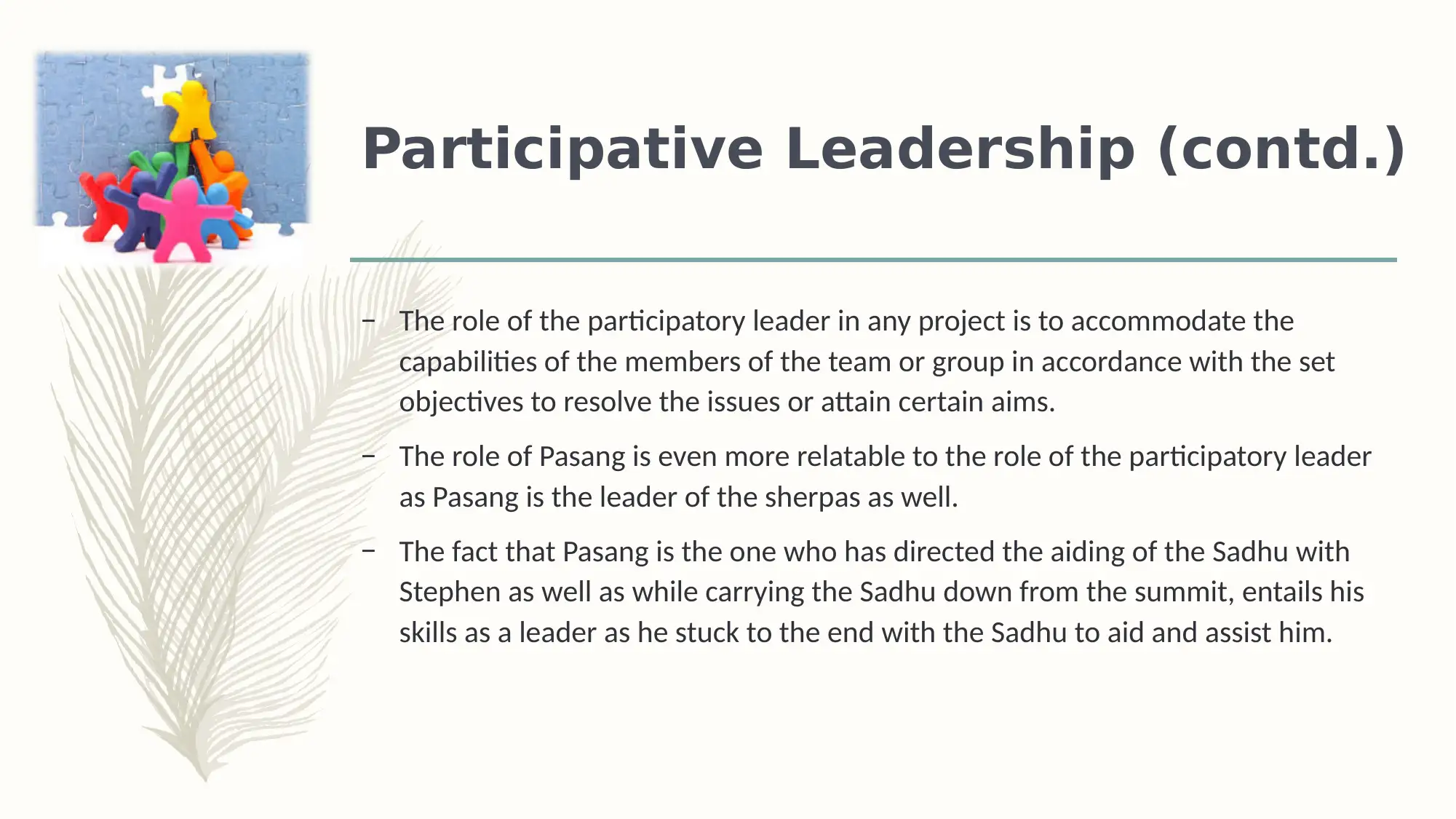
Participative Leadership (contd.)
– The role of the participatory leader in any project is to accommodate the
capabilities of the members of the team or group in accordance with the set
objectives to resolve the issues or attain certain aims.
– The role of Pasang is even more relatable to the role of the participatory leader
as Pasang is the leader of the sherpas as well.
– The fact that Pasang is the one who has directed the aiding of the Sadhu with
Stephen as well as while carrying the Sadhu down from the summit, entails his
skills as a leader as he stuck to the end with the Sadhu to aid and assist him.
– The role of the participatory leader in any project is to accommodate the
capabilities of the members of the team or group in accordance with the set
objectives to resolve the issues or attain certain aims.
– The role of Pasang is even more relatable to the role of the participatory leader
as Pasang is the leader of the sherpas as well.
– The fact that Pasang is the one who has directed the aiding of the Sadhu with
Stephen as well as while carrying the Sadhu down from the summit, entails his
skills as a leader as he stuck to the end with the Sadhu to aid and assist him.
Paraphrase This Document
Need a fresh take? Get an instant paraphrase of this document with our AI Paraphraser
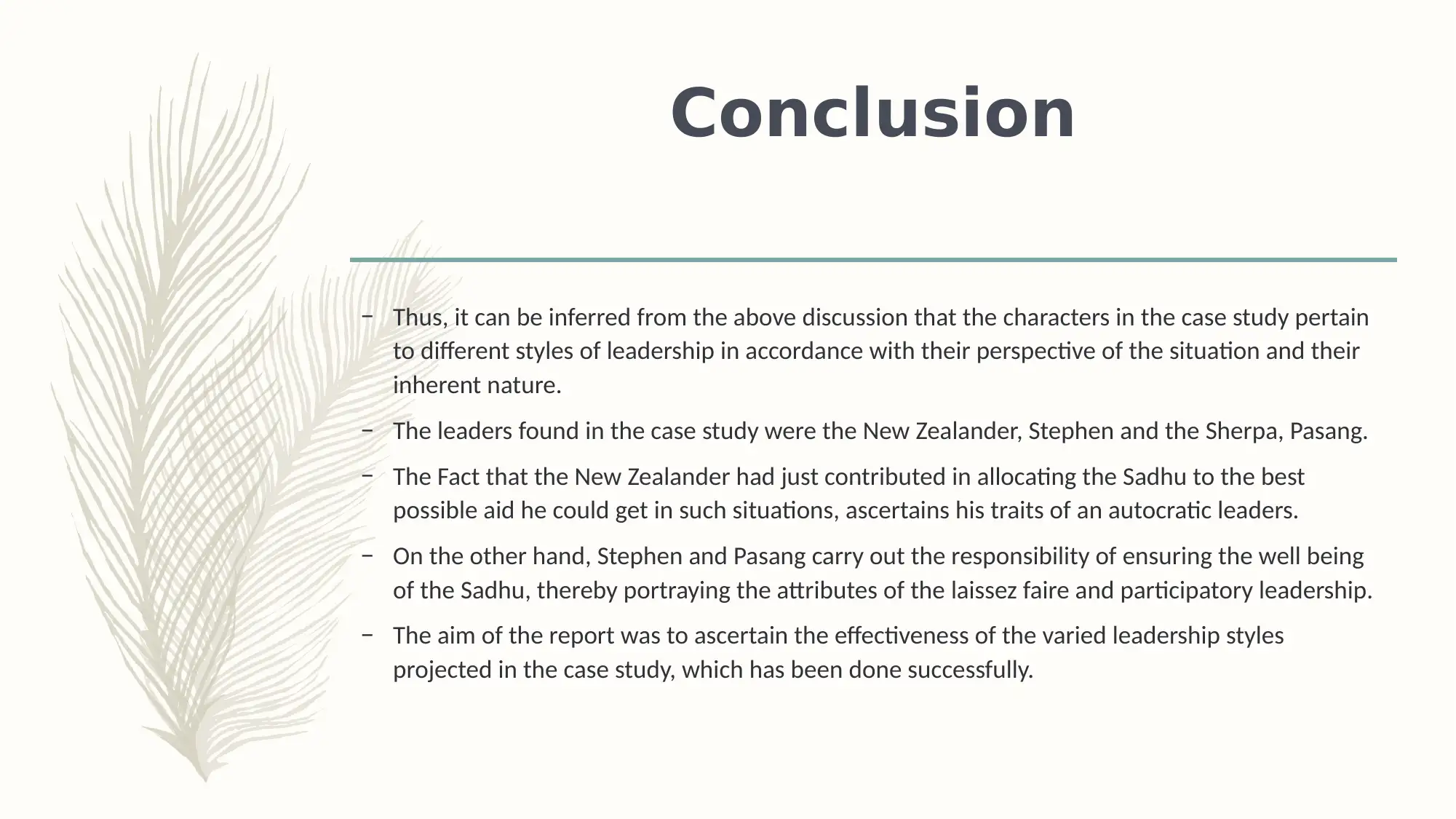
Conclusion
– Thus, it can be inferred from the above discussion that the characters in the case study pertain
to different styles of leadership in accordance with their perspective of the situation and their
inherent nature.
– The leaders found in the case study were the New Zealander, Stephen and the Sherpa, Pasang.
– The Fact that the New Zealander had just contributed in allocating the Sadhu to the best
possible aid he could get in such situations, ascertains his traits of an autocratic leaders.
– On the other hand, Stephen and Pasang carry out the responsibility of ensuring the well being
of the Sadhu, thereby portraying the attributes of the laissez faire and participatory leadership.
– The aim of the report was to ascertain the effectiveness of the varied leadership styles
projected in the case study, which has been done successfully.
– Thus, it can be inferred from the above discussion that the characters in the case study pertain
to different styles of leadership in accordance with their perspective of the situation and their
inherent nature.
– The leaders found in the case study were the New Zealander, Stephen and the Sherpa, Pasang.
– The Fact that the New Zealander had just contributed in allocating the Sadhu to the best
possible aid he could get in such situations, ascertains his traits of an autocratic leaders.
– On the other hand, Stephen and Pasang carry out the responsibility of ensuring the well being
of the Sadhu, thereby portraying the attributes of the laissez faire and participatory leadership.
– The aim of the report was to ascertain the effectiveness of the varied leadership styles
projected in the case study, which has been done successfully.

⊘ This is a preview!⊘
Do you want full access?
Subscribe today to unlock all pages.

Trusted by 1+ million students worldwide
1 out of 12
Related Documents
Your All-in-One AI-Powered Toolkit for Academic Success.
+13062052269
info@desklib.com
Available 24*7 on WhatsApp / Email
![[object Object]](/_next/static/media/star-bottom.7253800d.svg)
Unlock your academic potential
Copyright © 2020–2025 A2Z Services. All Rights Reserved. Developed and managed by ZUCOL.



